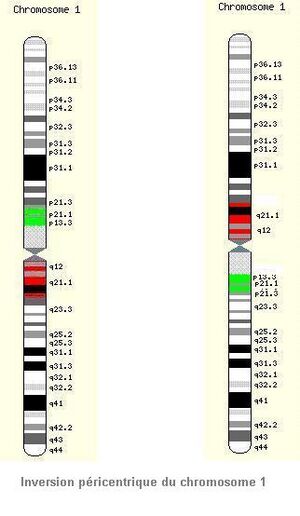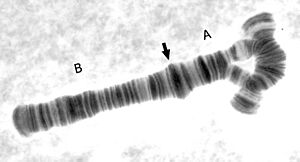Chromosome inversion facts for kids

An inversion is a change in a chromosome. Chromosomes are like tiny instruction books inside our cells. They tell our bodies how to grow and work. Sometimes, a part of a chromosome breaks off. Then, it flips around 180 degrees and reattaches itself. This means the order of the genes in that part is now reversed. It's like taking a sentence, cutting out a few words, flipping them backwards, and putting them back in.
Contents
What Happens with Chromosome Inversions?
The main thing that matters is how the inversion affects meiosis. Meiosis is a special type of cell division. It's how our bodies make sex cells, like sperm and egg cells. These cells are needed for reproduction.
When Both Chromosomes Match
Imagine you have two copies of each chromosome. If both copies have the exact same inversion, and no genes are missing or extra, then there's usually no problem. Meiosis can happen normally. It's like having two identical books, both with the same flipped sentence.
When Only One Chromosome Has an Inversion
Things get a bit tricky if only one chromosome in a pair has an inversion. During meiosis, chromosomes need to line up perfectly. They swap bits of DNA in a process called crossing-over.
If one chromosome has a flipped section, it has to form a special loop. This loop helps its genes line up with the normal chromosome. If crossing-over happens inside this loop, it can cause problems. The new sex cells might end up with too much or too little DNA.
Because of this, people with inversions in their sex cells might find it harder to have children. This is because some of their sex cells might not be healthy. Families who carry inversions can get special advice and tests from genetic counselors.
Images for kids
-
A clay model showing why heterozygous inversion loops are visible in polytene chromosome preparations
See also
 In Spanish: Inversión cromosómica para niños
In Spanish: Inversión cromosómica para niños



